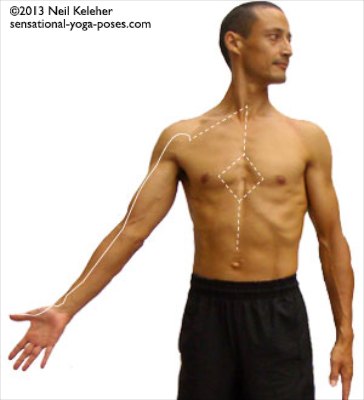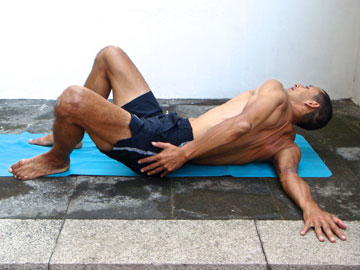Visualizing Your Lungs
The lungs fill the cavity within our ribcage. They sit on top of the diaphragm. The diaphragm separates the lungs from the liver, stomach, spleen and kidneys so we could visualize the lungs as sitting on top of these organs.
The diaphragm itself is an umbrella shaped sheet of muscle that, in most cases, presses downwards when it contracts. In so doing, it expands the volume of the lungs and causes an inhale.
The bottom or our lungs slope downwards from front to back so that the bottom edge is higher at the front than at the back. We can take this into account when attempting to visualize or "feel" our lungs. Also, because of the liver, which is on the right side of the body, the bottom of the right lung is slightly higher than the bottom of the left lung. When visualizing the lungs we need to make room between them for the heart and for the thoracic spine.
The Path of the Lung Meridian
 The Lung Meridian
The Lung MeridianThe lung meridian originates at a point within our body below the diaphragm. From this point it descends downwards to connect to the large intestine and then passes upwards to branch out to connect to either lung.
It emerges from each lung to pass up out of the base of the neck. It then branches out, still beneath the surface of the body, to emerge from the center point of the crease between the deltoid and the chest muscles.
It runs down the outside line of the front of the arm crossing the elbow and wrist to end at the thumb. Another branch splits of at the wrist to end at the index finger where it connects to the large intestine meridian.
It connects to the liver meridian at the lungs.
Stretching the Lung Meridian
 Stretching the Lung Meridian
Stretching the Lung MeridianA simple stretch for the lung meridian and for the front of the shoulder is to lay on the belly and reach one arm to the side so that it is at ninety degrees to the body.
Keep the palm facing downwards.
From there roll the opposite side of the body off of the floor. Imagine trying to roll over your reaching arm.
Slowly bend and lift both knees while keeping the feet on the floor. Allow the pelvis to turn so that the opposite side buttock relaxes down to the floor. To allow this to happen focus on relaxing the lower ribcage so that it can twist. Also relax the front of the shoulder being stretched.
Each inhale focus on expanding your ribcage slowly. Each exhale focus on relaxing.
This posture can stretch the lung meridian at the shoulder and also at the front of the elbow. It also stretches the heart and pericardium meridians.
Lung Meridian Meditation
Sense your ribcage and ribs.
- The seven uppermost ribs connect to the sternum to form the true ribs.
- The next three ribs connect to cartilage at the front of the ribcage to form the "costal arch." These are the false ribs.
- The two lowest ribs are short and their "front tips" are unattached to anything else. These are the floating ribs.
Imagine the lungs filling most of the space within your ribcage with space for your heart and thoracic spine.
- Imagine the lungs poking slightly out of the top of your ribcage.
- Imagine your lungs sitting on top of your liver which is on the right side of your body, and on top of the stomach and spleen which are on the left.
- You can also imagine the two kidneys at the back of your body beneath the back of your lungs.
You can also imagine space behind your heart for your esophagus and wind pipes.
- If you are breathing into your ribcage imagine your lungs expanding outwards each time you inhale.
- If you are using your diaphragm to breathe with imagine your lungs expanding downwards each time you inhale.
- If you are using your diaphragm and ribs at the same time imagine you lungs expanding outwards in all directions each time you inhale.
Feel the spaces between your ribs expanding and contracting as you breathe. Imagine your lungs within the space of your ribs. Imagine the connection of your ribs to your wind passage. Imagine this connection behind your heart. From here imagine a connection reaching down to connect to your large intestine.
Stay focused on the middle point of your large intestine. (It passes up the right side of your abdomen, crosses over to the left side below your liver and stomach, and then descends down the left side of your abdomen.) Now imagine a connection running upwards from this point to pass out of the throat and exit either arm at a point midway up the line that connects your deltoid to your chest.
Follow this line down the outer line of the front of your arm to your thumb. Imagine a branch from the wrist passing to the index finger.
- Each time you inhale breathe into your lungs and large intestine and at the same time imagine energy passing down the front of your arms down the lung meridian line of both arms.
- Each exhale relax your visualization and your body.
You might also visualize a white sword, metal.




